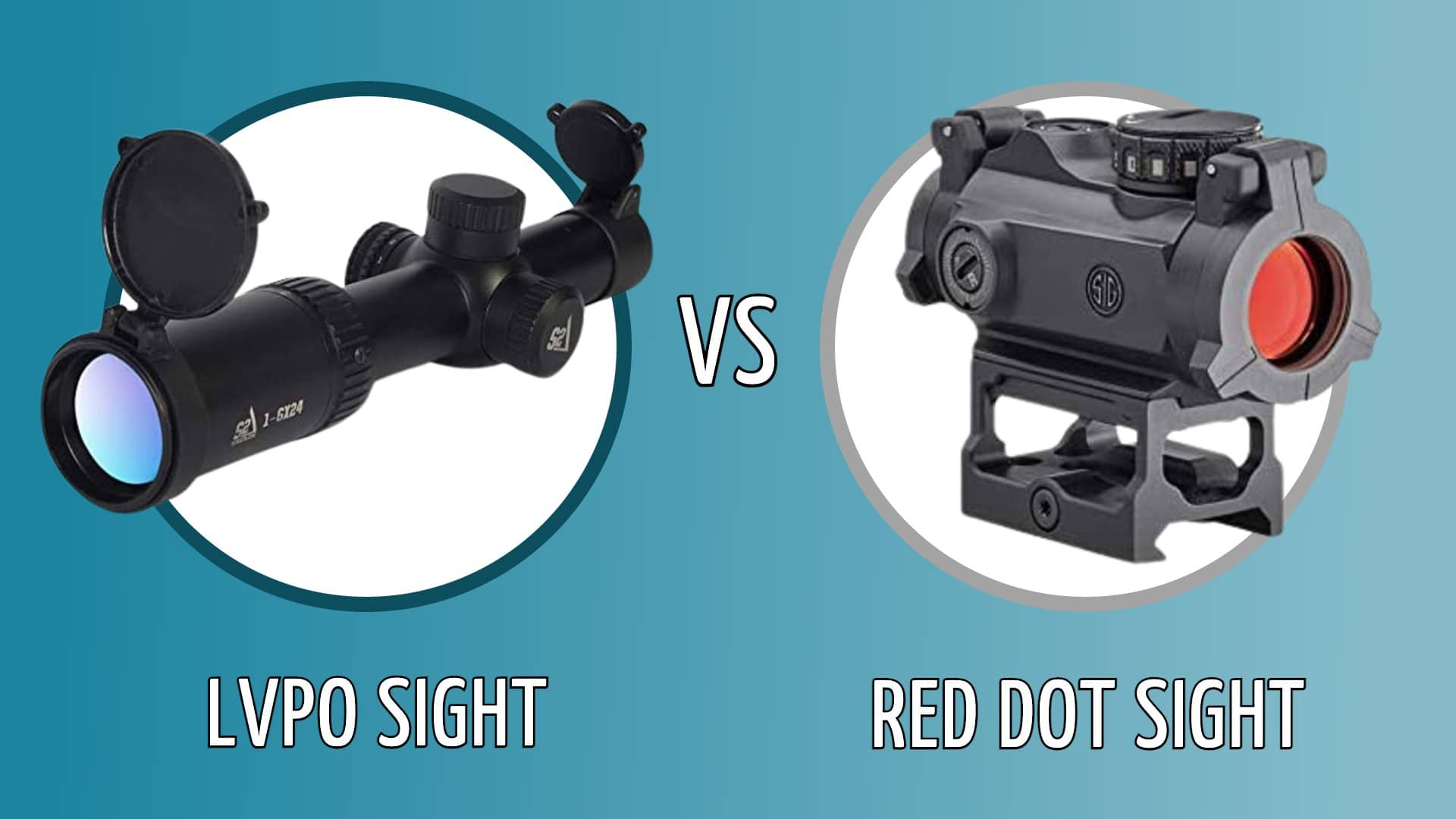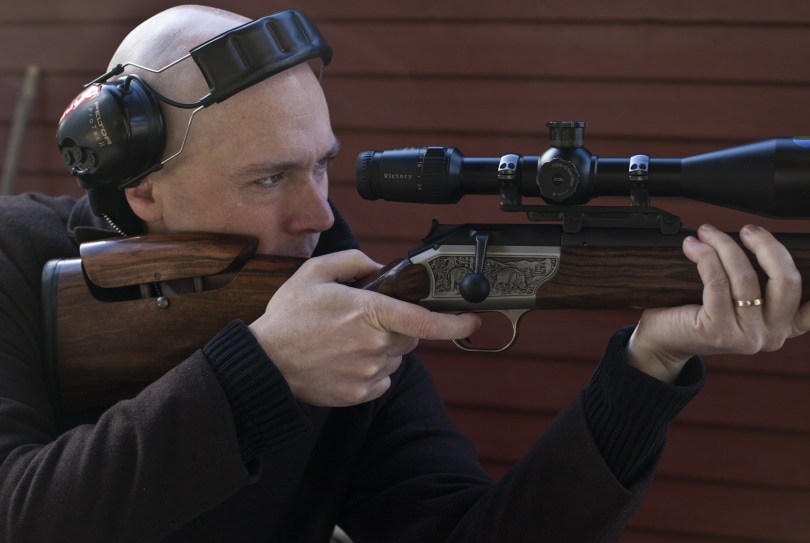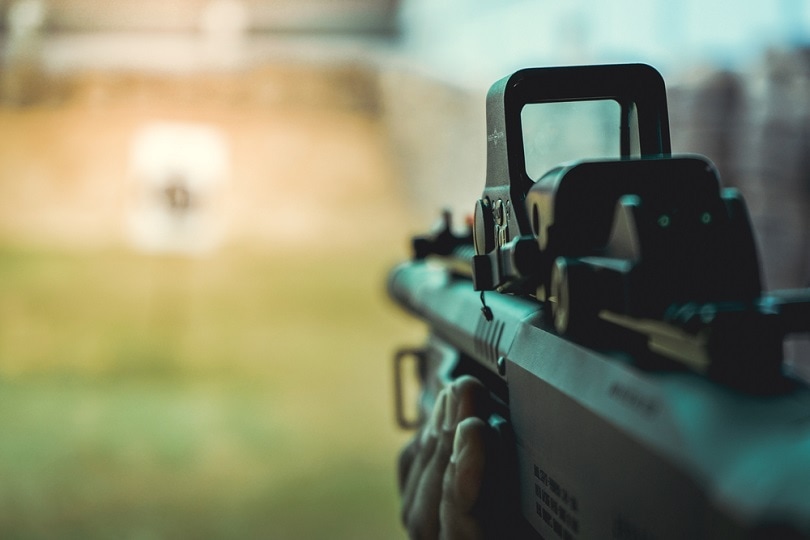LPVO vs. Red Dot Sights: Which Is Better?
Last Updated on

With so many scope options out there, it can be hard to determine which one is the best. While you might be looking for a clear winner across the board, the “best” really comes down to what you want to use it for.
That’s why we took the time to break down both types of sights. This way, you can learn everything that you need to know about these scope types and decide what’s best for you.

Overview of LPVO
LPVO stands for low-powered variable optic. In layman’s terms, it’s an optic with a true 1x magnification that you can increase to higher magnification levels. These sights don’t have the highest magnification levels compared to traditional scopes, but some of the premium options provide up to 10x magnification.
How LPVO Sights Work

LPVOs work like a traditional scope that magnifies objects with lenses. The difference is that an LPVO offers a true 1x magnification level, which can be incredibly useful for short-range encounters.
Since they have a variable magnification level, if you’re trying to shoot targets that are farther away, you can crank up the magnification to better see your target.
When You Want an LPVO

LPVOs are great scopes for those shooting at both short-range and mid-range targets. For non-tactical applications, LPVOs can be great for hunting mid-range targets or heading out to the range. They offer the advantage of hitting the closest possible targets without any parallax distortion.
If you are in the rare situation where you need a scope for tactical purposes, an LPVO can be a great choice. This is why they’re so popular with the military and special tactics police officers.
- Easier to hit targets at longer distances
- Adjustable magnification levels
- More expensive option
- They do not have unlimited eye relief

Overview of Red Dot Sights
One of the most common and popular sights is the red dot sight. This offers a slew of advantages for the everyday gun owner, which is why it’s so popular. Here’s exactly how a red dot works and when you would want one.
How Red Dot Sights Work
Red dot sights work by illuminating a small light at the center of the glass. This center is slightly tilted, which allows the light to shine off it and display a reticle for you. This is a simple design but it’s highly effective.

When You Want a Red Dot Sight
If you’re exclusively shooting at close-range targets or need to prioritize target acquisition speed over anything else, you want a red dot sight. For example, this would suit a weapon that you’re using for home defense, when you’re out hunting short game like turkeys, or any other short-range exclusive tasks.
Because red dot sights offer unlimited eye relief and are easy to use, you can fire them out of unconventional positions without sacrificing accuracy. This is a critical feature for home defense, as you might be shooting from behind something instead of being able to line up your shot like you would at the range.
- More affordable option
- Unlimited eye relief
- Quicker target acquisition
- No magnification settings
Which Is Right for You?
We’re confident in saying that a red dot sight is right for you most of the time. However, it ultimately depends on what you’re using it for. If you’re attaching a scope to an airsoft gun for tactical applications or part of a special operations unit, an LPVO is probably the right choice.
But for most people, red dot sights are more useful. That’s because their unlimited eye relief is better suited for most short-range applications. If you’re looking for a scope that can hit mid-range targets while you’re hunting, you’re usually better off with a traditional scope.
Other Factors to Consider
Before purchasing any scope, you need to be honest with yourself: How skilled of a shooter are you? Red dot sights are far easier to use, and if you’re not going to spend the time at the range to learn your new scope, you probably don’t want an LPVO.
There’s nothing wrong with an LPVO, and if you take the time to become an expert marksman, you can mitigate many of the drawbacks. But for the average user, there are going to be stark differences.
Of course, you’re going to want to consider the brand of whatever sights you’re looking at. In that vein, it’s best to compare across the same brand when looking at a red dot sight and an LPVO. This will give you an accurate representation of the difference in style, instead of the brand that you’re looking at.
The Price Factor
There’s no doubt that you can find a high-quality red dot sight for far less money than a high-quality LPVO. While the starting price point for a top-notch red dot sight is close to $100, the starting point for an LPVO is $400.
If you’re looking for the best of the best, the difference is even starker. You can find some of the best red dot sights for close to $800, while the best LPVOs can cost close to $3,000. If you’re looking for the more affordable option, the red dot sight is the clear winner.

In Conclusion
With so many scope options out there, it can be hard to find what’s perfect for you. The good news is that you’ve come to the right place. We hope this guide comparing two sights will help you pick out the best one for your needs.
Check out some of our top trending comparisons:
About the Author Robert Sparks
Robert’s obsession with all things optical started early in life, when his optician father would bring home prototypes for Robert to play with. Nowadays, Robert is dedicated to helping others find the right optics for their needs. His hobbies include astronomy, astrophysics, and model building. Originally from Newark, NJ, he resides in Santa Fe, New Mexico, where the nighttime skies are filled with glittering stars.
Related Articles:
Binocular Magnification Chart: Numbers & Distances Compared
How to Clean a Refractor Telescope: Step-by-Step Guide
How to Clean a Telescope Eyepiece: Step-by-Step Guide
How to Clean a Rifle Scope: 8 Expert Tips
Monocular vs Telescope: Differences Explained (With Pictures)
What Is a Monocular Used For? 8 Common Functions
How to Clean a Telescope Mirror: 8 Expert Tips
Brightfield vs Phase Contrast Microscopy: The Differences Explained
